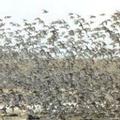 學名Brachyramphus marmoratus的斑海雀,是一種體型大小與知更鳥相近的海鳥。他們是棲息築巢在生長古老或成熟樹種中的唯一鳥種。1991年美國華盛頓州外海Tenyo Maru號漁船漏油事故,對海鳥棲地形成嚴重威脅,據估計,沿岸900英畝的森林需耗時200年來復原,以保護列為聯邦保育類動物的斑海雀。當地部落、州以及聯邦官員代表1日集聚尼亞海灣(Neah Bay),見證一項斥資520萬美金的棲地重建計劃,以彌補當年漏油事故對沿海魚類與野生生物所釀成之傷害。
學名Brachyramphus marmoratus的斑海雀,是一種體型大小與知更鳥相近的海鳥。他們是棲息築巢在生長古老或成熟樹種中的唯一鳥種。1991年美國華盛頓州外海Tenyo Maru號漁船漏油事故,對海鳥棲地形成嚴重威脅,據估計,沿岸900英畝的森林需耗時200年來復原,以保護列為聯邦保育類動物的斑海雀。當地部落、州以及聯邦官員代表1日集聚尼亞海灣(Neah Bay),見證一項斥資520萬美金的棲地重建計劃,以彌補當年漏油事故對沿海魚類與野生生物所釀成之傷害。
這項為期200年的計劃主要是為了保護900英畝的斑海雀海岸林築巢繁殖棲地。這種小型的海鳥被聯邦政府列為瀕危物種,因日本籍Tenyo Maru號漁漏油而飽受威脅。該艘漁船在美國最西邊的領土福拉德利角(Cape Flattery)外海西北方23海浬處,沈沒在540英呎深的海底。
Tenyo Maru號漁船在1991年7月22日的濃霧中被中國籍貨輪土匪號(Tuo Hai)撞上後隨即沈沒。這起意外事件發生在美加邊界北方一小段距離的加拿大水域內。
 接下來的數月內,船隻持續排放出超過10萬加侖的油進入沿海水域。溢油污染了海灘並且戕殺了溫哥華海島到北俄勒岡州的野生動物。最厚重的油層位於瑪凱印第安保護區和奧林匹克國家公園的海岸線一帶。
接下來的數月內,船隻持續排放出超過10萬加侖的油進入沿海水域。溢油污染了海灘並且戕殺了溫哥華海島到北俄勒岡州的野生動物。最厚重的油層位於瑪凱印第安保護區和奧林匹克國家公園的海岸線一帶。
科學家估計華盛頓州外海約有7-11%的斑海雀在這次溢油意外中死亡。
學名Brachyramphus marmoratus的斑海雀,是一種體型大小與知更鳥相近的海鳥。他們是棲息築巢在生長古老或成熟樹種中的唯一鳥種。
斑海雀並不建造巢穴,而是在生長在高大且古老的大樹枝幹上的地衣、苔蘇表層修築淺淺的凹巢然後僅僅產下一個蛋。由於這類的海岸林棲地因伐木和經濟發展而日益稀少,連帶地也使得斑海雀的數量大為減少,在1992年,斑海雀名列受威脅瀕臨絕跡物種保護法令中。
與Tenyo Maru號碰撞的中國貨輪船家支付了900萬美金的罰鍰,這筆金額將做為由原住民部族、州及聯邦政府機構所籌設的特別基金會。費用中的520萬將用來做為斑海雀及其他海鳥族群復原及保育計劃中的耳標標記工作,其他的380萬則用來貼補該機構處理溢油污染的支出。
A 1991 oil spill that harmed seabird populations along Washington's outer coast has resulted in 200 years of protection for 900 acres of coastal forests, which are critical nesting areas for federally protected marbled murrelets. Tribal, state and federal officials gathered Tuesday in Neah Bay to mark the completion of a $5.2 million habitat restoration plan to offset damages to Washington's fish and wildlife populations during the 1991 Tenyo Maru oil spill.
A cornerstone of the plan is the 200 year protection of 900 acres of coastal forest nesting habitat for marbled murrelets. Federally listed as threatened, the tiny seabirds were harmed by oil after the Japanese fish processing vessel Tenyo Maru sank in 540 feet of water about 23 miles northwest of Cape Flattery, the westernmost U.S. point of land.
The Tenyo Maru sank immediately after it was struck by the Chinese freighter Tuo Hai in heavy fog on July 22, 1991. The collision occurred in Canadian waters a short distance north of the United States-Canada border.
Over the following month, the vessel released more than 100,000 gallons of oil into coastal waters. The spill fouled beaches and killed wildlife from Vancouver Island to northern Oregon. The heaviest oiling occurred along the Makah Indian Reservation and Olympic National Park shoreline.
Scientists estimate that seven to 11 percent of the marbled murrelet population along Washington's outer coast were killed in the oil spill.
Marbled murrelets, Brachyramphus marmoratus, are seabirds about the size of a robin. They are the only seabirds whose nesting habitat is in old growth or mature trees.
Murrelets do not build nests, instead they make shallow depressions in the moss that grows on large, old tree limbs and lay a single egg. Because of the losses in this type of coastal forest habitat to logging and development, the number of murrelets has declined, and in 1992, the marbled murrelet was listed on as threatened under the Endangered Species Act.
The owner of the Chinese freighter that collided with the Tenyo Maru paid a $9 million penalty that went into a special fund created by tribal, state and federal agencies. Of the total amount, $5.2 million was earmarked for restoration and preservation projects for marbled murrelets and other seabirds. The other $3.8 million went to recover expenses for agencies that responded to the spill.

